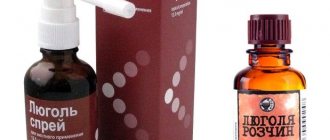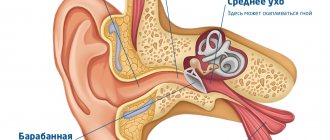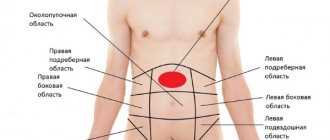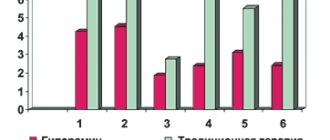Local therapist
Efimova
Natalia Vladimirovna
21 years of experience
District doctor-therapist of the first category
Make an appointment
Adenoviral infection is a pathological process that occurs when an adenovirus (Adenoviridae) enters the human body. The disease is accompanied by damage to the respiratory system, eyes, gastrointestinal tract and lymphatic system. Infected patients suffer from intoxication, fever, loss of voice, cough, and intestinal disorders. The diagnosis is made based on the clinical picture of the disease and the results of laboratory tests. During the treatment process, adults and children receive antiviral drugs, immunomodulators and drugs that relieve acute symptoms of infection.
General information about pathology
Adenovirus belongs to the group of respiratory viral infections. The course of the disease is complicated by conjunctivitis, nasopharyngitis, lymphadenopathy, and dyspeptic syndrome. The share of adenoviral infections in the overall structure of ARVI reaches 20%.
The risk group includes patients aged six months to three years. Almost all preschool children have been infected with adenovirus at least once. The pathology does not have a pronounced seasonality: the incidence rate remains stable throughout the year. Treatment of the disease is carried out under the supervision of a pediatrician and otolaryngologist.
Folk remedies
Photo: img04.rl0.ru
Herbal medicine is considered the most harmless and effective option for self-medication with folk remedies. If symptoms of the disease occur, it is recommended to drink plenty of warm liquid:
- herbal tea (chamomile, calendula) with honey;
- warmed milk with honey;
- infusion with rose hips, lingonberries, viburnum berries or strawberries;
- drinks made from linden flowers, viburnum fruits;
- a mixture of linden and elderberry;
- Brewed summer adonis herb with the addition of honey.
The most popular methods of treating adenovirus infection with folk remedies are infusions of honey, Cahors and aloe leaves aged for at least 2 weeks, cocktails of egg yolks, butter and honey, warm liquids with onion juice and honey. It is recommended to consume garlic - its essential oils have immunostimulating properties. The nasal mucosa can be lubricated with Kalanchoe juice. To combat unpleasant symptoms, use:
- A sore throat . Rinsing with a solution of soda and salt, infusion of oak bark, calendula and St. John's wort, propolis tincture, solutions of vegetable oils.
- Dry cough . Eliminated with warm decoctions from the “breast collection”. Alkaline liquids are beneficial. Warm milk with a pinch of soda or heated mineral water will do.
- Conjunctivitis . The eyes are washed with chamomile solution and warm tea.
Treatment of adenovirus infection with folk remedies cannot be carried out independently. The use of any prescriptions is possible only in consultation with a doctor.
The information is for reference only and is not a guide to action. Do not self-medicate. At the first symptoms of the disease, consult a doctor.
Reasons for the development of pathology
Virologists have identified three dozen pathogens belonging to the Adenoviridae family. Infectious agents are adapted to long-term survival in unfavorable conditions and tolerate freezing temperatures and low environmental humidity. The DNA of pathogens is destroyed by ultraviolet radiation and chlorine-based chemicals.
Infected patients spread pathogens by secreting nasopharyngeal mucus. A significant number of viral agents are contained in feces. The main routes of infection for healthy people are airborne and fecal-oral. Swimming pool visitors can become infected after contact with water in which a carrier of the pathogen has swam.
A patient who has had an adenovirus infection is immune to a certain type of virus. A child or adult may become ill again when exposed to a carrier of a different Adenoviridae serotype. A similar mechanism of transmission of adenovirus from person to person is typical for nosocomial infections.
Mechanism of infection
The first manifestations of adenovirus begin to bother the patient after pathogens enter the mucous membranes of the respiratory tract and intestines or the conjunctiva of the eye. Viruses reproduce in epithelial cells, lymph nodes and lymphoid formations of the intestine. After the incubation period is completed, the affected cells die - the viruses enter the human circulatory system.
In places of primary damage to the mucous membranes, edema forms. The typical location of the inflammation is the posterior wall of the pharynx. The inflammatory process occurs against the background of abundant exudate. If left untreated, the patient may experience damage to the bronchi, kidneys, liver and spleen.
Medicines
Photo: infectium.ru
Currently, there is no specific medicine against adenoviruses. Antiviral drugs with complex action based on interferons can be used. Some researchers question their effectiveness due to the lack of sufficient evidence. Treatment includes symptomatic therapy and combating complications.
Symptomatic therapy
The list of medications is determined by the symptoms of adenoviral infection:
- Hyperthermia . Antipyretics are indicated when the temperature reaches 38.5°C. In addition to eliminating hyperthermia, the drugs reduce pain in the head and throat. Adults are prescribed tablet forms, and young children are prescribed syrups and suppositories.
- Conjunctivitis . Eye drops and rinses are recommended; if signs of purulent inflammation appear, ointments placed behind the eyelid.
- Runny nose . For rinsing, saline solution and seawater-based products are used. For nasal congestion, medications with a vasoconstrictor effect are effective.
- Cough . Depending on the type of cough, bronchodilators, thinners and expectorants may be prescribed.
- Severe swelling . For severe swelling of the mucous membrane of the nasal passages and upper respiratory tract, antihistamines are effective.
Any medications are prescribed by a doctor, taking into account the age-related dosage - this measure helps to avoid disruption of the kidneys, liver, heart and gastrointestinal tract.
Prevention and treatment of complications
To prevent severe consequences due to bacterial complications (otitis, sinusitis, pneumonia, meningitis, encephalitis), treatment with antibacterial agents is carried out. The standard rule is to focus on symptoms - if after 3-4 days of conventional therapy the patient does not improve, it means that a bacterial infection has joined the main infection and antibiotics are required.
In cases where the patient has suppressed immunity (due to HIV carriage, radiation sickness, therapy for autoimmune diseases), doctors prescribe antibacterial drugs from the first day of illness. The selection of medications is carried out individually, taking into account the patient’s age and the nature of the complications. Broad-spectrum antibiotics are used as a prophylactic agent and at the initial stage of treatment of bacterial infections. After receiving the culture results, the medication is replaced taking into account the sensitivity of the pathogen.
Symptoms of pathology
Symptoms of adenovirus entering the human body are specific and depend on the form the infection has taken. If the respiratory tract is damaged, pharyngitis, tonsillopharyngitis and bronchitis can develop. If the infection penetrates the tissues of the conjunctiva, patients suffer from pharyngoconjunctival fever and acute conjunctivitis. The entry of viruses of the Adenoviridae family into the intestinal mucosa provokes the development of diarrhea syndrome.
Patients may experience mild, moderate, or severe disease. In some cases, the pathology is complicated by the addition of a secondary infection. The incubation period lasts from five to seven days. Upon completion, the patient feels a sharp increase in body temperature (up to 38–39 degrees). Later, typical signs of adenovirus infection appear:
- decreased appetite;
- apathy, lethargy;
- muscle and joint pain;
- fever;
- dehydration.
The listed symptoms of adenovirus develop in children and adults within several hours after the temperature rises. Without treatment, patients' condition quickly deteriorates.
Laboratory diagnostics
One of the research methods is laboratory diagnosis of adenoviral infection. For this purpose, blood and urine tests are taken from the patient. There are no significant changes in the hemogram; the number of leukocytes remains within normal limits. In the initial period of the disease, lymphopenia can be observed, as well as slight leukocytosis with neutrophilia. However, the blood picture does not play a significant role in diagnosis, since it is not specific.
A urine test can show the presence of an inflammatory process in the body, but in most cases it remains within normal limits. Just like a blood test, it is not specific.
Conjunctival damage
Reproduction of viruses in the tissues of the conjunctiva leads to the development of conjunctivitis of various forms: catarrhal, follicular and membranous. The pathological process begins to develop in one eye, but gradually affects the second. Patients complain of pain, burning, and foreign body sensation. An ophthalmological examination reveals redness and swelling of the skin of the eyelids. In some cases, doctors record the formation of a dense whitish film on the conjunctiva. Advanced adenovirus infection is complicated by keratitis.
Serological diagnosis
To retrospectively confirm the presence of adenoviral infection, serological diagnosis is widely used, which is carried out by several simple and accessible methods:
ELISA – enzyme-linked immunosorbent assay.
RSK – complement fixation reaction.
HRA – hemagglutination inhibition reaction.
The material to be studied for the above methods is the patient’s blood serum taken from a vein. The advantages of these research methods are the simplicity of their implementation and the ability to obtain quick results.
Diagnostic measures
Diagnosis is performed by a therapist or otolaryngologist - the doctor examines a patient with signs of adenovirus infection. The medical history of a child or adult includes objective data on symptoms: fever, conjunctivitis, respiratory failure, intestinal disorders. Confirmation of the primary diagnosis is carried out during laboratory tests of the patient’s biomaterials - blood, nasopharyngeal smears, scrapings from the conjunctiva, feces.
Differential diagnosis allows you to exclude influenza, infectious mononucleosis, pharyngeal diphtheria, and mycoplasma infection from a person’s history. If laboratory test results are unclear, the physician may refer the patient for an ophthalmological examination.
Immunofluorescence
The immunofluorescence reaction - RIF allows you to identify certain antigens based on the processing of the test material, namely scrapings from the mucous membrane of the genitourinary tract. The advantage of this method is its simplicity and speed of obtaining results (within an hour). The accuracy limits are 60-80%, which requires additional research. As a rule, RIF is carried out in combination with another method - immune electron microscopy (IEM) of viruses treated with specific antibodies.
Forecast and preventive measures
With an uncomplicated course of the disease, patients achieve complete recovery in five to seven days. A complicated form of adenoviral infection may require hospitalization of a child or adult. In this case, the recovery time increases by 1.5–2 times.
If there is a sharp increase in adenovirus infection in kindergartens or schools, doctors recommend specific prevention. Virus carriers must be referred for outpatient or inpatient treatment. All premises of educational institutions should be treated with antiseptic solutions.
Why do adenovirus infections most often affect children?
During the first 6 months of life, children practically do not suffer from adenovirus infection. This is due to the fact that at this age children have passive immunity, inherited from their mother. Then innate immunity is lost, and children begin to get sick.
Until the age of 7 years, a child manages to get sick with adenovirus infection several times. Each time the body develops specific immunity to a specific type of adenovirus, but since there are several of them, the child has to get sick more than once. After 7 years, as a rule, they already have acquired immunity to all types of adenoviruses, and they are no longer afraid of adenovirus infection.
Over time, immunity is lost, so adenovirus infections can also affect adults.










